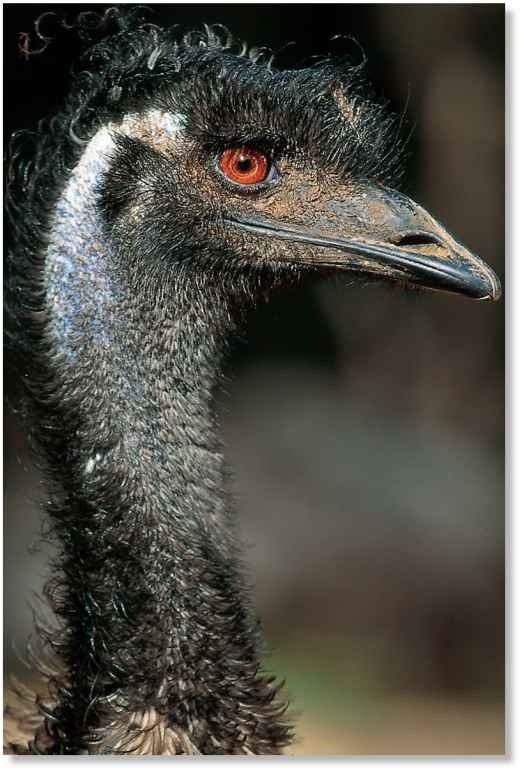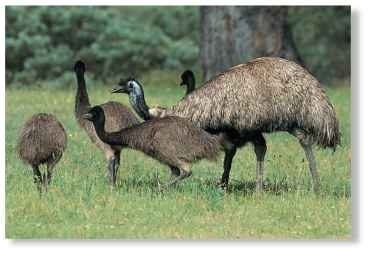ORDER
Casuariiformes
FAMILY
Dromaiidae
GENUS & SPECIES
KEY FEATURES
• Distributed widely across Australia in a wide range of habitats
• Second in size only I to the ostrich, which lives in Africa, this huge bird is similarly flightless and relies on its ability to run fast when threatened
• unusual among birds, the male emu incubates the eggs and rears the brood without assistance from the female
WHERE IN THE WORLD?
Throughout much of Australia, the emu is found in a wide variety of habitats — from coastal flats, woodlands and grassy plains to the uplands of the | Great Dividing Range
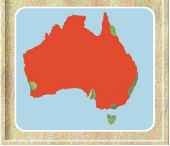
Lifecycle
A wanderer by nature, the emu adopts a more settled existence in the breeding season; the male dutifully tends to his brood and defends it fiercely against intruders.
HABITAT
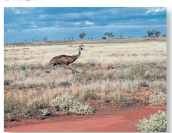
On the plain Nomadic, the emu follows the rains for food.
In the bush Open woodland on plains provides cover.
The emu is found in a variety of habitats, avoiding only desert and tropical forest. Around 700,000 birds are dispersed across woodlands, shrublands and grassy plains — from the tropical north to temperate south and from coastal flats up to the Great Dividing Range.
The emu avoids Australia’s arid heartland, but may occur in desert after rains or where water is available. Emus may turn up in unlikely settings while migrating, such as plowed fields or suburbs. It abandons its nomadic life only in the breeding season, when it moves to reliable food supplies, away from human disturbance.
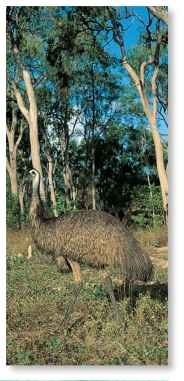
CONSERVATION
The emu isn’t currently under threat, but its numbers decline in times of drought. It has benefited from the provision of water for livestock in arid areas. In Western Australia, the emu is raised on farms for its meat, feathers, oil and leather; the state government also funds research of emu rearing.
FOOD & FEEDING
BREEDING
The emu looks for a mate in December; in the middle of the Australian summer: Once a bond is formed, the pair stays together while the male builds a nesting platform of grass, twigs, bark and leaves. After mating, the female lays a clutch of green, oval eggs and then, as incubation begins, she leaves her mate and may mate again with other males. Sometimes several females mate with a male and lay their eggs in his nest, leaving him with several clutches of eggs to incubate.The male stays within his nesting territory, defending it until the chicks hatch.
The young hatch well developed and bear camouflage stripes that they keep for about ten weeks. In a few hours they can walk and soon the brood leads, rather than follows, the male. In most cases, the young stay with the father for five months before leaving, but in dry conditions, when food is short and chicks develop slowly, parental duties may continue for a year or more.
TENDER LOVING CARE
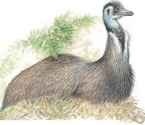
1 Sitting…
With utmost devotion, the male emu incubates the eggs alone. For eight weeks, neither eating nor drinking, he rarely leaves the nest.
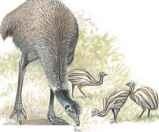
2 Feeding…
After hatching, the chicks forage with their father, keeping close by his side and sheltering under his feathers when the family settles for the night.
The emu’s diet depends largely on what’s available. If there’s a varied food supply it prefers to pick out the most nutritious items, such as seeds and flowers. Tender shoots and leaves are also favored, along with insects and the occasional small verte-brate,such as a lizard or rodent.The emu resorts to coarse leaves and grass if it’s the only food available in a particular area.
The emu forages at a walking pace, with its head held straight out or low to the ground. Plant matter is either plucked in passing or gleaned from the ground, then swallowed with a backward toss of the head. Feeding takes
place only in daylight hours. If an emu is disturbed, it races away to cover at up to 30
Pecking order A father and his brood feed close to the woods.
mph.
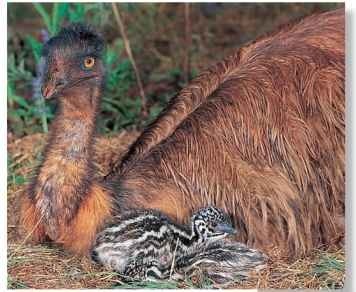
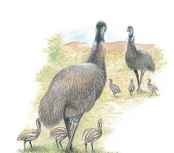
3 Strolling…
Though young chicks of different broods will mix freely, their fathers are more wary and act aggressively to drive off the other brood.
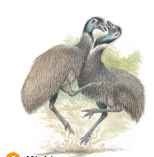
4 Kicking
If two males stand their ground, a violent fight can ensue, starting with pecking, then forward kicks and finally ending with a chase.
BEHAVIOR
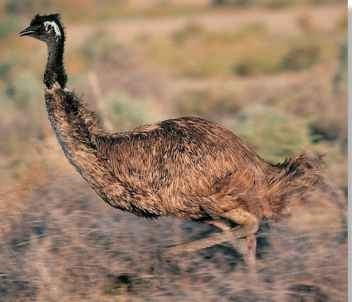
A Wanderer
An adult may wander about 950 miles in a year.
Although it frequently occurs alone or in pairs, the emu is a sociable bird that may roam in small groups or loose flocks.
Outside the breeding season, the bird rarely maintains any territorial claims it may have made. It wanders freely from place to place, eating and drinking to build up fat reserves. An emu can travel for days without food and, in lean times, lives off this fat reserve, surviving losses of up to half its total bodyweight.
The emu’s mobility enables it to make seasonal migrations across the drier western parts of Australia, following the rainfall pattern. At times, nomadic bands join together to form flocks of several hundred. These can cause severe damage to crops — so severe, in fact, that a vast fence 600 miles long has been erected to keep the emu away from the arable lands of the southwest.
The emu is a shy but curious bird, drawn to unusual objects. Aboriginal hunters, hidden in trees, would dangle balls of feathers to lure an inquisitive emu into range.
Due to damage done by emus to grain crops, the Australian army was enlisted to control the situation by shooting large numbers of birds in the so-called ‘Emu Wars’ of 1932.
Profile
Emu
The long, powerful legs of the emu compensate for its heavy body, small wings and shaggy plumage, which prevent it from flying.
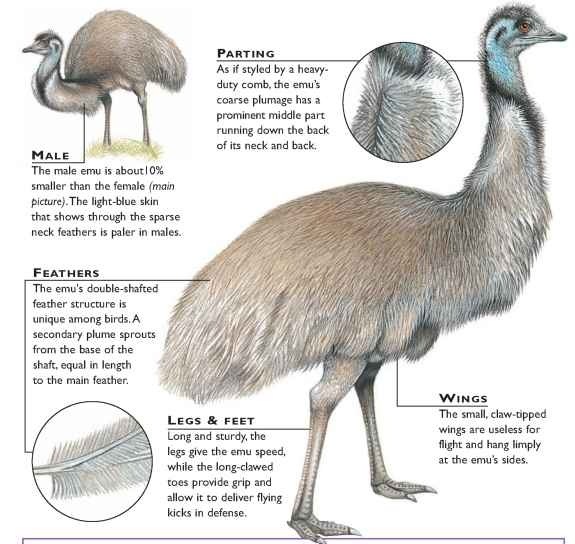
CREATURE COMPARISONS
The greater rhea (Rhea americana) from South America has much in common with the emu. Shorter and of slimmer build, the rhea is a giant among birds even though its bodyweight is about half that of the emu. Like the emu, it’s a flightless bird, built for walking. It has long legs and a neck designed for foraging at ground level in open terrain. Like the emu, the greater rhea male takes sole responsibility for the incubation and upbringing of its offspring.
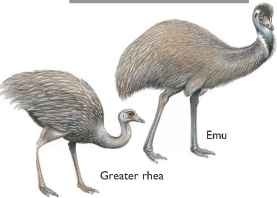
| VITAL STATISTICS | |
| Weight | 77-110 lbs. |
| Height | 5-6′ to top of head; 3-4′ to top of back |
| Sexual Maturity | 2 years |
| Breeding Season | April-June |
| Number of Eggs | 7-11 |
| Incubation Period | 8 weeks |
| Breeding Interval | Usually 1 year |
| Typical Diet | Seeds, fruits, flowers, shoots and insects |
| Lifespan | 6 years |
RELATED SPECIES
• The emu is the only member of its family, but j is related to the double-wattled cassowary (Casuarius casuarius) in the Casuariiformes order. Standing 3′ high to the | top of its back, it’s Australia’s only other large flightless bird. Their ranges overlap in places, but the two species are unlikely to meet; the cassowary is confined to a habitat the emu avoids — the tropical forests of northeastern Australia.
